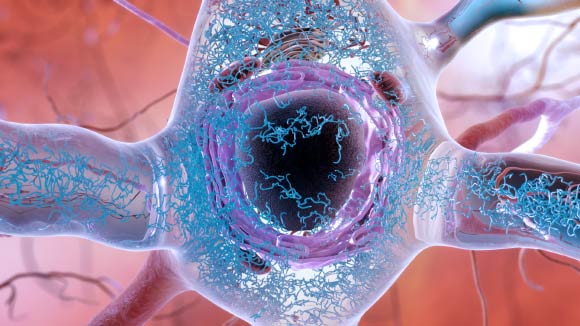A team of researchers from the University of Texas Southwestern Medical Center, the University of Delaware and Washington University in St. Louis has discovered a ‘Big Bang’ of Alzheimer’s disease — the precise point at which the inert form of a protein called tau becomes toxic but has not yet formed deadly tangles in the brain. The findings appear in the journal eLife.

Abnormal accumulations of a protein called tau can collect inside neurons, forming tangled threads and eventually harming the synaptic connection between neurons. Image credit: National Institute on Aging / National Institutes of Health.
“When doctors perform autopsies to look at the brain tissue of people with Alzheimer’s disease, they find toxic buildups of tau protein in structures called aggregates. People with more severe dementia have more tau aggregates in their brain,” the scientists said.
“Aggregates form when individual proteins stick together in repetitive patterns, much like the way a single Lego block might attach to another identical one. Normally folded tau proteins do not form aggregates.”
The team, led by University of Texas researchers Dr. Marc Diamond and Dr. Lukasz Joachimiak, has now discovered that in the good form of tau the parts of the protein that allow it to stick to itself are hidden, folded inside.
By contrast, the bad form of tau exposes the parts that allow it to aggregate, enabling the protein to build upon itself to form a large, toxic assembly.
“This is perhaps the biggest finding we have made to date, though it will likely be some time before any benefits materialize in the clinic,” Dr. Diamond said.
“This changes much of how we think about the problem.”
“Our study contradicts the previous belief that an isolated tau protein has no distinct shape and is only harmful after it begins to assemble with other tau proteins to form the distinct tangles seen in the brains of Alzheimer’s patients.”
Dr. Diamond, Dr. Joachimiak and their colleagues made the discovery after extracting tau proteins from human brains and isolating them as single molecules.
They found that the bad form of tau exposes a part of itself that is normally folded inside. This exposed portion causes it to stick to other tau proteins, enabling the formation of tangles that kill neurons.
“We think of this as the ‘Big Bang’ of tau pathology,” Dr. Diamond said.
“This is a way of peering to the very beginning of the disease process. It moves us backward to a very discreet point where we see the appearance of the first molecular change that leads to neurodegeneration in Alzheimer’s.”
“Tafamidis, a recently approved drug, stabilizes a different shape-shifting protein called transthyretin that causes deadly protein accumulation in the heart, similar to how tau overwhelms the brain,” he added.
“The hunt is on to build on this finding and make a treatment that blocks the neurodegeneration process where it begins. If it works, the incidence of Alzheimer’s disease could be substantially reduced. That would be amazing.”
_____
Hilda Mirbaha et al. 2018. Inert and seed-competent tau monomers suggest structural origins of aggregation. eLife 7: e36584; doi: 10.7554/eLife.36584







